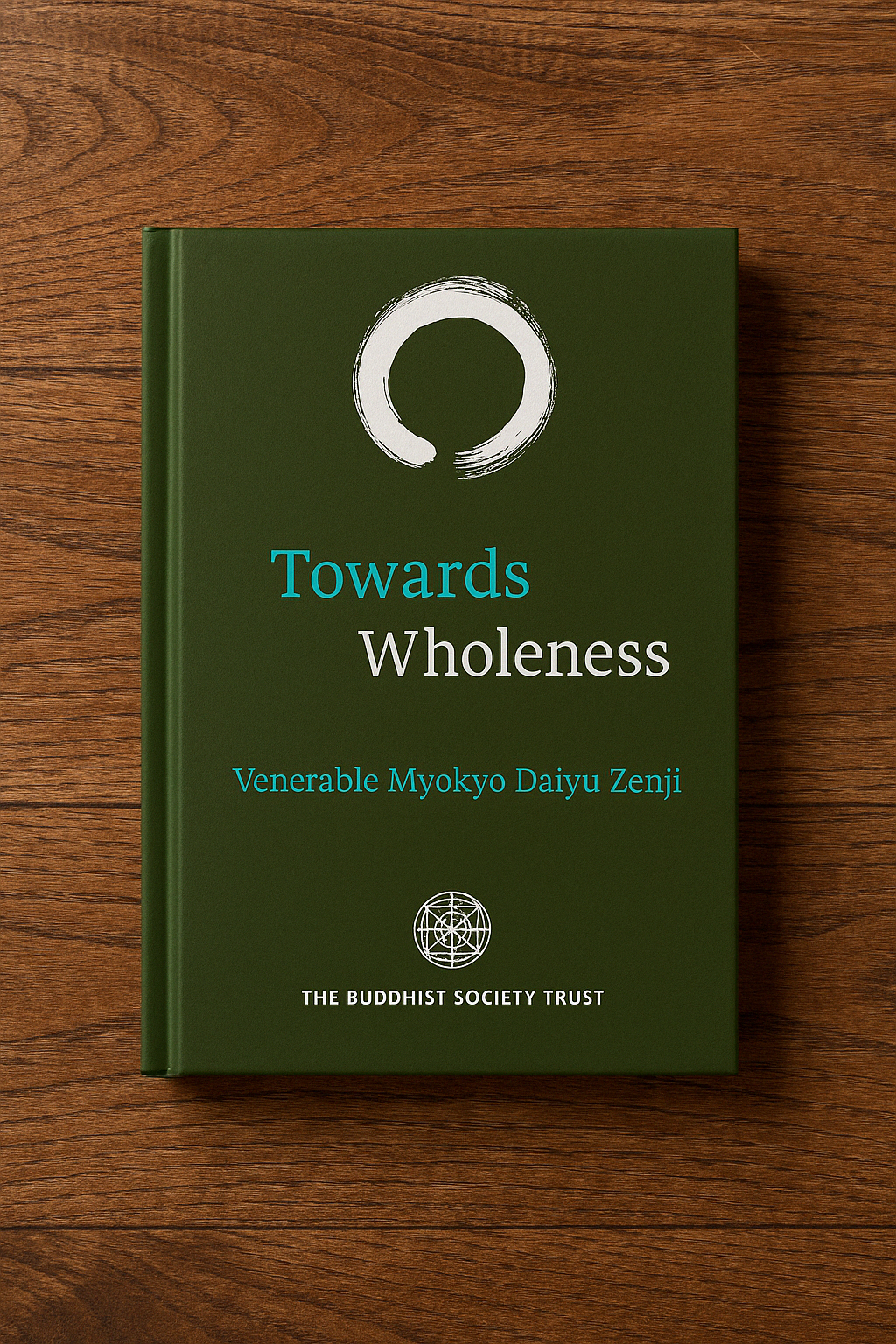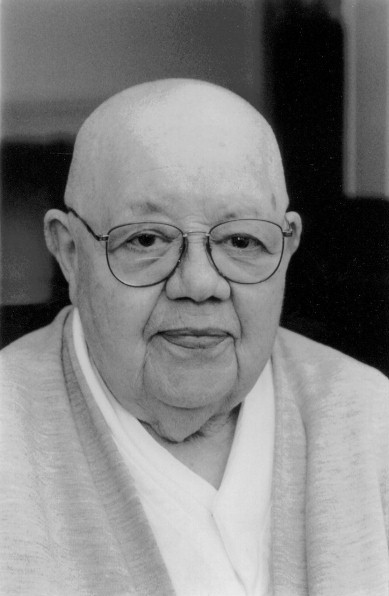Towards Wholeness by Venerable Myokyo Daiyu Zenji
Book Review
Towards Wholeness comprises a series of articles which Venerable Myokyo-ni wrote after her final return from Japan in 1972, and which were then published serially in Zen Traces from 1980 onwards.

AI generated image of the book cover
ChatGPT
They were brought together into one publication with each article appearing separately under a different chapter heading. Thanks to the diligent care of Michelle Bromley, who instigated and carried out the arrangement, Towards Wholeness was published in 2018 by The Buddhist Society Trust, in conjunction with The Hokun Trust.
One feels in these writings the depth and breadth of the insight which Ven Myokyo-ni brought back with her from the twelve years of rigorous Zen training which she underwent in Daitokoji monastery under two renowned and traditional teachers, to whom she always said she was deeply and eternally grateful. They are written in a refreshingly new and strong manner and the pages pulse with her warmth, wisdom, common-sense, straightforwardness and humour.
The title Towards Wholeness is telling. What is wholeness? In this context it is the full expression and life of each one of us and therefore a connectedness with all that is.
P.9 “In our little round of bestirring ourselves, and getting tired, we lose sight of this relatedness in which we have our being and without which the sap of life dries up in us”.
We all long for this, whether consciously or not. The book details how to search for and find this wholeness. However, ‘towards’ tells us that finding wholeness and living from it is not a given. It requires the good fortune of encountering a path and a guide with which we can feel a genuine affinity and then our own sustained effort to keep following it.
P.12 “Good quality sells itself to the discerning eye; what is glisteningly wrapped up- well, that is good salesmanship, it need not be good quality. Also, whether we like it or not, good quality is connected with time and effort spent. And something ineffable but strangely homelike clings to it, an unspectacular simplicity which fits, which is not contrived or strained, but natural”.
P.15 “Though this way has many names, it is but One Way. Experienced and described differently by different wayfarers, with different landmarks and stages set up by different traditions, it is the same way, and walking upon it taxes all pilgrims with the same difficulties, and opens up the same vistas for all travellers”.
So, this is not solely a book about Buddhist practice, but about the spiritual search inherent in all mankind, about things ‘grave and constant in human experience’. With depth, knowledge and understanding, Ven Myokyo-ni writes about other paths – Christianity, Carl Gustav Jung’s way to Individuation, the Chinese Tao and Yin/Yang, and notes that all mythologies worldwide have symbols and rituals of such nature. These chapters are fascinating and open out our view of our own practice. There is also a chapter on the Bull Herding pictures which illustrate this transformation so beautifully and helpfully.
P.148 “The discipline of learning to contain, in full awareness, the dark side in which the Fires flare, this is the way towards wholeness. The way implies suffering the presence of the dark side, suffering it without avoidance, without defense, neither giving way nor being carried away, suffering it to draw near, and nearer. That suffering confrontation is death to ‘I’, the Great Death of which Master Hakuin speaks. In that ‘passion’ of suffering a shift occurs, the emotional energy itself undergoes transformation. And with that a re-union has taken place”.

Daiyu Myokyo Zenji (Myokyo-ni)
By The Zen Centre - The Zen Centre, CC BY-SA 3.0, https://commons.wikimedia.org/w/index.php?curid=63954775
P.149 “The transforming factor lies in the effort of wholly giving myself, and by so doing grace emerges. It is truly given if I but stick to my part. With grace is also given the strength, the warmth and the light of a joyous partaking, which is a service by living the wholeness of life, of what is, and living fully because deeply moved by the mystery and miracle of what is”
The final seven chapters are specifically about Zen Buddhist practise, with a detailed explanation of what is necessary, the pitfalls and how to encounter and come through these pitfalls. Chapter 12 which precedes these seven, contains a wonderful and illustrative clothes-washing analogy:
P.163 “We have only just started. And since life has often been linked to a stream, we find ourselves on its bank with a bundle of dirty washing which we all carry. It has already taken us a good time to accept the bundle of washing, and to find the river. We know little of washing and care even less about it. To get that bundle clean as quickly as possible is what we want… Life just cannot be only this washing. Yet in the end, having tried every escape route to no avail, we give in, bow the head and accept the washing.… And sometimes we have leisure to talk to our neighbours to share our experiences. It is a good life after all. We also have learnt to take care not to soil our clothes too much, to avoid those stains that are really hard to remove. Now we have quite a bit of time at our disposal. As we look along the endless line of washers, will we criticise them, and vie with our neighbours? Or can we let go and also look upstream where only now, on fine days we behold the still older ones we had not seen before. They are a strange spectacle; there they crouch, half-naked and happy. They no longer need soap or detergent. Their pile of washing is gone; only one or two rags are left and those so threadbare that with the long- acquired skill of avoiding bad stains, they pick up only a little dirt, so that a few effortless and almost dancing movements through the clean water at the river’s mouth are all that is needed. They chat and laugh and sing.
Has one wasted a life learning how to wash? Has one acquired the skill of an experienced master for nothing? Again, the final sacrifice. Can one accept what one sees, what is so different from all that one was led to expect and has found and forged for oneself? Can one lay down one’s craftsman’s pride? If so, one realises at that moment that those strange and laughing creatures, though seemingly they do nothing, very much have their place in the scheme of things; for the words of their song come over clearly and reveal the secret: there is an end to washing when the washing is washed away”.
As with being in the presence of Ven Myokyo-ni, or that of anyone who embodies such a state of being, this book supports us all the way through our life and training. From whatever angle, the answer is there, reassuringly familiar, even if hard to face. I recommend it to anyone interested in, at whatever level, the spiritual journey.
(Towards Wholeness by Venerable Myokyo Daiyu Zenji pub. The Buddhist Society Trust, 2018).
Available from The Zen Centre London




